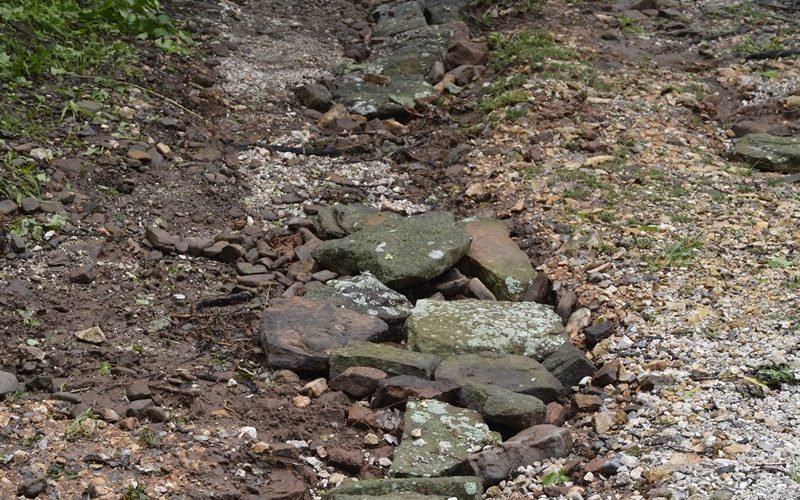
Staff Photo Amanda Bancroft
Erosion doesn’t affect just water quality and soil nutrients – this gravel road near Fayetteville looked like rapids during recent storms, exposing rocks that can damage tires
Rain can be fun. Kids play in it, rainbows emerge from it, and adults can sit on their porch with some lemonade and a good book while listening to the droplets pitter-pat on rooftops and walkways. These non-porous surfaces sure do make a great soundtrack of contentment, until the house gets washed away and all those droplets seem to say f-you in unison. Floods have been an exciting and devastating part of recent life in Northwest Arkansas. Nature is wild, but there are a few ways humans can be erosion warriors and reduce the chances of flood waters running rampant next week, next year, or when the grandkids inherit your home.
Erosion can have long-term impacts affecting future generations and our water quality, so it’s great to do what we can to prevent it now. Start by assessing where the water flows. Notice problem areas, and note any non-porous surfaces like parking lots that stop water from seeping into the ground, increase the speed and quantity of flow, and allow toxins from cars to get washed into the waterways. Two main goals to fight erosion are “slow it down” and “seep it deep.”
Compacted soil doesn’t drain well and is less porous; the water has trouble seeping in, gains speed, and carries away topsoil. Stepping stones or pathways might help keep traffic to a smaller area. Plant native grasses or a rain garden to soak up and retain excess rainwater. Mulch can be a big help, too. There are many kinds, and even an erosion control mulch mat for slopes. Or you can just use grass clippings (be careful about spreading invasive non-native grass seeds, though).
Retaining walls made of stone can double as terraced, attractive garden beds. It’s best to consult someone in case building permits are required, and they can help you get the right wall slope to avoid pooling water at each step. Improving drainage, such as adding a gravel or French drain around the house, might help soggy basements that tend to get moldy. There are lots of books and how-to articles, but the basic idea is a trench with rocks designed to filter and relocate water away from sensitive areas like a house.
For gardeners, drip irrigation systems are a nice way to conserve water and reduce over-watering. This gives your nutritious topsoil a chance to stay put instead of getting washed away. Bare soil is vulnerable soil, so mulching or keeping soils covered with plants or grasses year-round is best. No-till gardens are really great because they avoid compacting the soil, and methods like lasagna gardening are popular. Keep livestock away from riverbanks or eroded soil, and consider pasture rotation to let the grass recover.
Sometimes, there’s nothing we can do to stop a river from overflowing its banks, but small actions taken by erosion warriors can make a big difference in a neighborhood.
Amanda Bancroft is a writer, artist, and naturalist building an off-grid cottage for land conservation on Mt. Kessler. She and her husband Ryan blog about their adventures and offer a solar-hosted online educational center on how to make a difference with everyday choices at: www.RipplesBlog.org.










